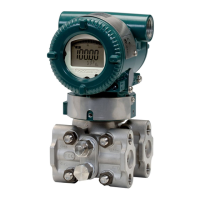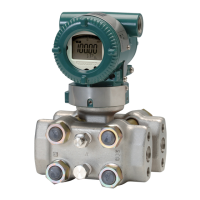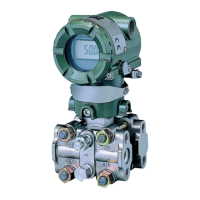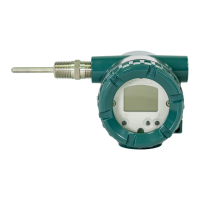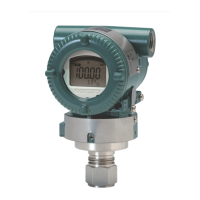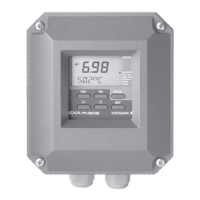<2. Handling Cautions>
10
IM 01C25A01-01E
Model: EJX-F Series Date: January 27, 2005
Rev.4: July 16, 2019 Doc. No.: IFM024-A12 P.2
Yokogawa Electric Corpor ation
IFM 024
Specific conditions of use:
- Precautions sh all be taken to mi nimize the risk from electrostatic discharge of
painted parts.
- When the enc losure of the Pressure Transmitters is m ade of aluminum alloy, if it is
mounted in Zone 0, i t shall be installed such that, ev en in the event of rare incidents,
an ignition source due to im pact and/or f riction s parks is exc luded.
Entity parameters [Groups: A, B, C, D, E, F, G, and II C]
Ui : 24 V
Ii : 250 mA
Pi : 1.2 W
Ci: 3.52 nF
Li: 0 µH
FIS CO parameters (1) [Groups: A, B, C, D, E, F, G, and I IC]
Ui : 17.5 V
Ii : 380 mA
Pi : 5.32 W
Ci: 3.52 nF
Li : 0 µH
FIS CO parameters (2) [Groups: C, D, E, F, G, and IIB]
Ui : 17.5 V
Ii : 460 mA
Pi : 5.32 W
Ci: 3.52 nF
Li : 0 µH
Notes:
1. Installation mu st be i n accordance with the National Electric Code (NFPA70),
ANSI/ISA-RP12.06.01, and relevant local codes.
2. The Associated Apparatus and the Terminators must be FM -approved.
3. The f ollowing conditions must be satisfied.
Ui
Isc i
i
4. General Purpose Equipment connected to the Associated Apparatus must not use or
generate a voltage more than Um of the Associated Apparatus.
5. The c ontrol drawing of the Associ ated Apparatus mu st be followed whe n installing the
equipment.
6. Dust- tight condu it seals mu st be used when installed i n Class II or Clas s III
environments.
7. WARNIN G –ELECTROSTATIC CHARGE MAY CAUS E AN EXPLOSION HAZARD.
AVOID ANY ACTIONS THAT CAUS E THE GENERATIO N O F ELECTROSTATIC
CHARGE, SUCH AS RUBBING WITH A DRY C LOTH ON COATING FACE OF THE
PRODUCT.
8. WARNIN G – SUB STITUTION OF COM PONENTS MAY IMPAI R INTRINSIC SAFETY
AND SUITABILITY FOR HAZARDOUS LOCATION
Model: EJX-F Series Date: May 9, 2006
Rev.1: July 16, 2019 Doc. No.: I FM024-A12 P.2-1
Yokogawa Electric Corpor ation
IFM 024
FISCO Rules
The FISCO Concept allows the interconnection of intrinsically safe apparatus to associated apparatus
not specifically examined in such combination. The criterion for such interconnection is that the
voltage (Ui), the current (Ii) and the power (Pi) which intrinsically safe apparatus can receive and
remain intrinsically safe, considering faults, must be equal or greater than the voltage (Uo, Voc or Vt),
the current (Io, Isc or It) and the power (Po) which can be provided by the associated apparatus
(supply unit). In addition, the maximum unprotected residual capacitance (Ci) and inductance (Li) of
each apparatus (other than terminators) connected to the Fieldbus must be less than or equal to 5 nF
and 10 H respectively.
In each I.S. Fieldbus segment only one active source, normally the associated apparatus, is allowed to
provide the necessary power for the Fieldbus system. The allowed voltage (Uo, Voc or Vt) of the
associated apparatus used to supply the bus cable must be limited to the range of 14 V d.c. to 17.5 V d.c.
All other equipment connected to the bus cable has to be passive, meaning that the apparatus is not
allowed to provide energy to the system, except a leakage current of 50
Separately powered equipment needs galvanic isolation to ensure the intrinsically safe Fieldbus
circuit remains passive.
The cable used to interconnect the devices needs to comply with the following parameters:
Loop resistance R': 15....150 /km
Inductance per unit length L': 0.4....1 mH/km
Capacitance per unit length C': 45....200 nF/km C' = C' line/line + 0.5 C' line/screen, if both lines are
floating or C' = C' line/line + C'line/screen, if the screen is connected to one line.
Length of spur cable: max. 60 m
Length of trunk cable: max. 1 km in IIC and 5 km in IIB
Length of splice: max = 1 m
Terminators
At the end of each trunk cable an FM Approved line terminator with the following parameters is
suitable:
R = 90...100
C = 0 ....2.2 F
Model: EJX-F Series Date: January 27, 2005
Rev.1: July 16, 2019 Doc. No.: IFM024-A12 P.3
Yokogawa Electric Corpor ation
IFM 024
Equipment
Control drawing (nonincendiv e)
Class I, II, D i visio n 2
Group s A, B, C, D , F, G
Class III, D i vis ion 1
Class I, Zo n e 2, G roup IIC
(Refer to N o te 3 )
Model: EJX-F Series Date: January 27, 2005
Rev.5: July 16, 2019 Doc. No.: IFM024-A12 P.4-1
Yokogawa Electric Corpor ation
IFM 024
Nonincendive field wiring parameters
Vmax: 32 V
Ci: 3.52 nF
Li: 0 µH
Notes:
1. Installation mu st be in ac cordance with the National Electric Code (NFPA70),
ANSI/ISA-RP12.06.01, and relevant local codes.
2. The f ollowing conditions must be satisfied.
3. In case Nonincendive Field Wiri ng Concept is used f or the interconnecti on,
FM-appr oved Associated Nonincendive Field Wiring Apparatus, whi ch meets the
following conditions, m ust be used as the General Purpose Equ ipment. The
Terminators als o must be FM approved.
Vmax
4. Dust-ti ght conduit seals m ust be used when installed i n Class II or Class III
environments.
5. WARNIN G – SUBSTITUTION OF COMPONENTS MAY IMPAIR INTRINSIC SAFETY
AND SUITABILITY FOR HAZARD OUS LOCATION
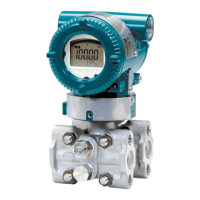
